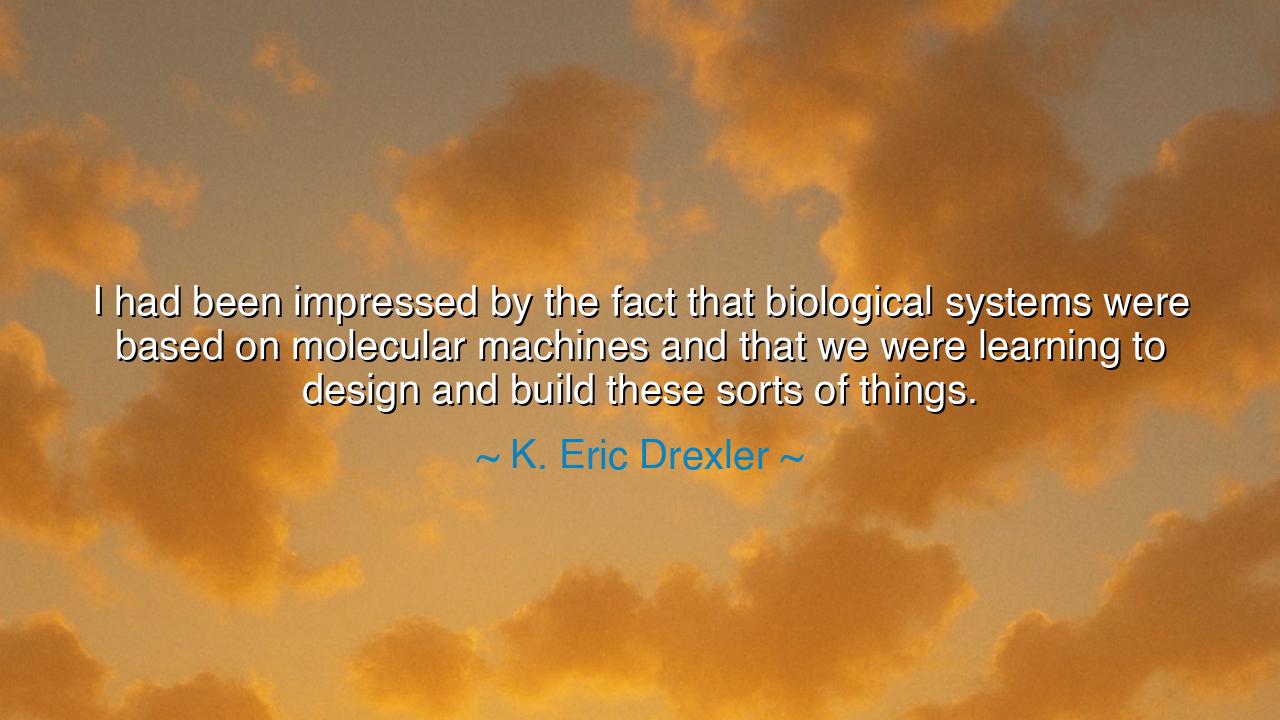
I had been impressed by the fact that biological systems were
I had been impressed by the fact that biological systems were based on molecular machines and that we were learning to design and build these sorts of things.






“I had been impressed by the fact that biological systems were based on molecular machines and that we were learning to design and build these sorts of things.” Thus spoke K. Eric Drexler, the visionary father of nanotechnology, whose imagination bridged the living cell and the workshop of human creation. His words are not merely those of a scientist—they are the proclamation of a prophet of the microscopic, one who saw within the smallest workings of life the blueprint for a new age of invention. For in this reflection lies an ancient truth renewed: that all creation, whether born of nature or shaped by human hands, follows one grand design—the architecture of purpose.
In the days of the ancients, philosophers spoke of the world as a great machine, divinely ordered, where each part—sun, wind, sea, and seed—played its role in the eternal harmony. Yet only in the modern era did humankind gaze deeply enough into matter to see that the machinery of life itself runs not on cogs of iron but on molecules of meaning—tiny engines built from atoms, each performing its task with precision older than time. Drexler, struck by this revelation, saw in the cell not chaos but order, not mystery alone but design—a design so profound that it invited imitation. If nature could build machines at the molecular scale, could not humanity, too, learn to craft such wonders?
This vision was no idle fancy. In the closing decades of the twentieth century, Drexler became one of the first to speak of a world where machines the size of molecules could heal the sick, purify the air, repair damaged cells, and assemble materials atom by atom. To some, his dream seemed like madness; to others, it was revelation. But Drexler’s inspiration came not from fantasy, but from biology itself—from the revelation that the human body, every leaf, every living thing, is already proof that molecular machinery is possible. The ribosome, the enzyme, the DNA polymerase—these are the factories of life, humming within us even now. In their perfection, Drexler saw the future of engineering, a future where humanity learns not only to build, but to build as nature does.
The ancients, too, would have recognized the sacred pattern in his discovery. For to imitate the craftsmanship of nature is to walk in reverence of the divine. Just as the sculptor studies the curve of the human form to carve his marble, or the architect studies the mountain to design his temple, so too must the modern creator study the living world to craft his miracles. Drexler’s awe before the molecular machine is not mere scientific curiosity—it is the modern echo of the ancient craftsman’s worship. It is the cry of one who sees that intelligence and design are woven into the fabric of existence, and that we, as co-creators, are called to understand and extend that pattern with care.
But his words also bear a warning, quiet yet urgent. To build is a sacred act, and to build at the scale of life itself is to hold the power of both creation and destruction. Just as fire, once tamed, became both hearth and weapon, so too could the mastery of the molecular world bring healing or ruin. The wise must remember that every tool of power must be guided by conscience, and every advance by humility. For the one who creates without wisdom becomes like the Titan who steals the fire of the gods only to be consumed by it. Drexler’s vision, therefore, is not only a celebration of human potential but a call to responsible creation—to align invention with life, not against it.
History teaches us this balance. When Jonas Salk created the first successful polio vaccine, he refused to patent it, saying, “Could you patent the sun?” He saw that some inventions belong not to the maker, but to the whole of humanity. Likewise, the pioneers of molecular design must see their craft not as conquest, but as stewardship. For the machines we build within the invisible realms of the atom may one day shape the destiny of the visible world. In every innovation, therefore, let there be both awe and restraint, both imagination and moral clarity.
So let this teaching be your guide: study nature not as a thing to master, but as a teacher to learn from. When you gaze upon a leaf, a cell, or a strand of DNA, know that you look upon the work of a master builder older than the stars. And if you seek to design, to build, to innovate, do so with reverence for that ancient artistry. Let your creations serve life, not vanity; let your machines echo the harmony of the living world.
For as K. Eric Drexler reminds us, the future will belong not to those who command the atom, but to those who understand the soul within it—those who, impressed by the miracle of molecular design, carry that wonder forward with wisdom, humility, and hope.






AAdministratorAdministrator
Welcome, honored guests. Please leave a comment, we will respond soon